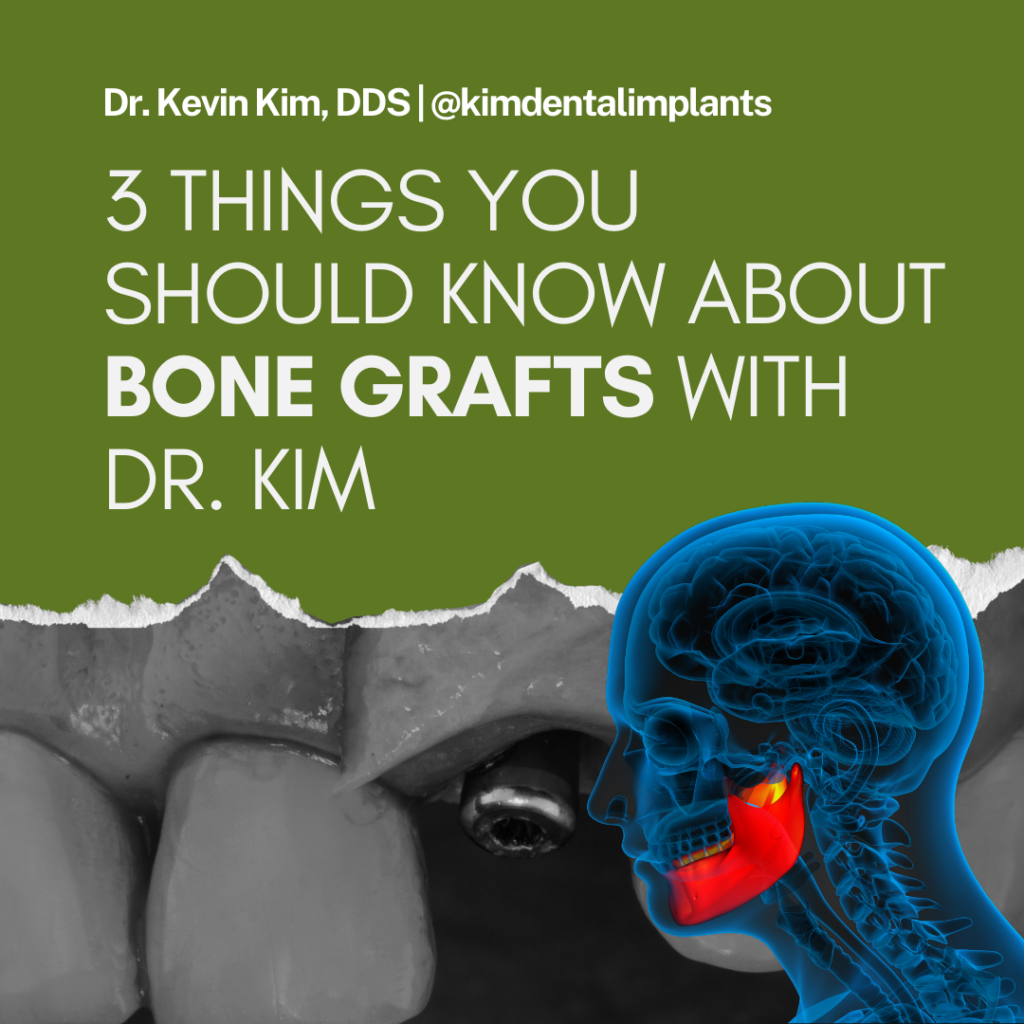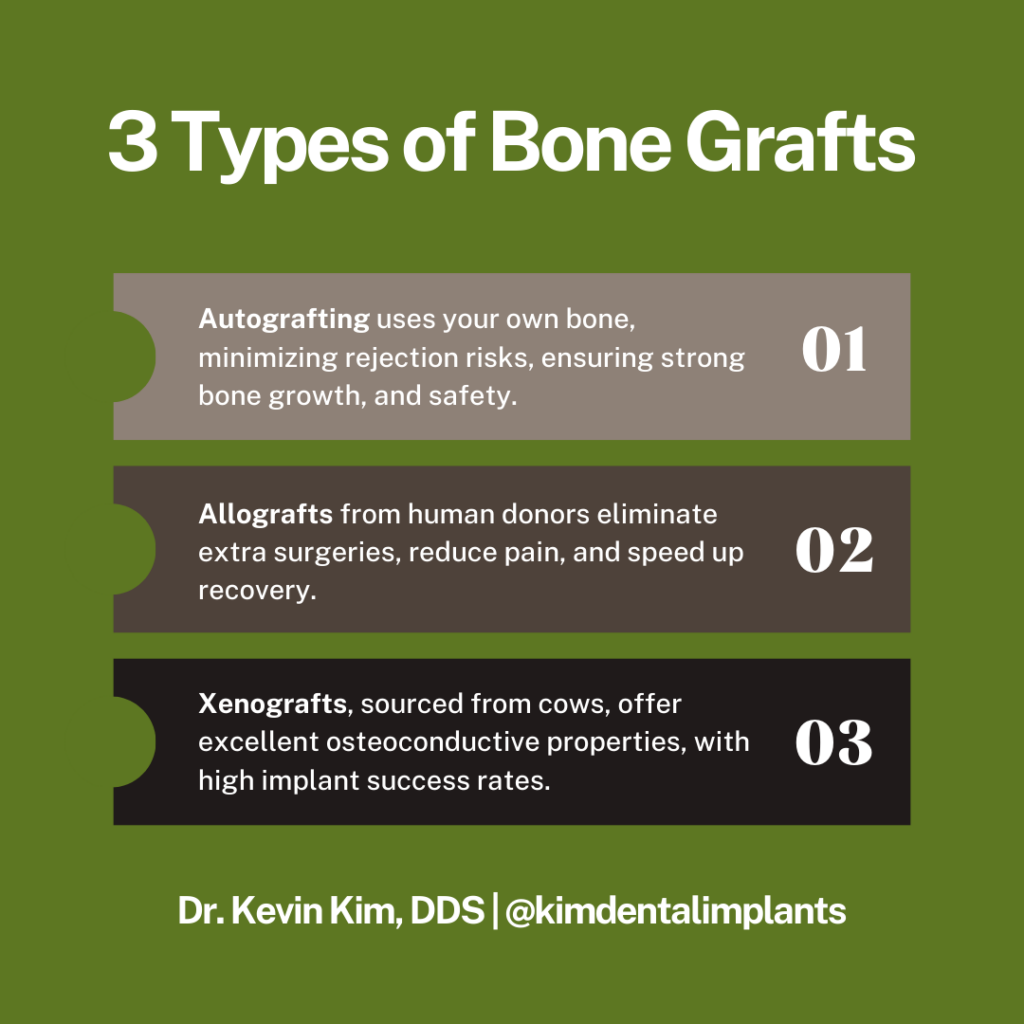3 Things You Should Know About Bone Grafts with Dr. Kim

As 2025 approaches, take advantage of the expanding options for smile restoration with the latest advancements in dental implant technology and bone grafts. At Kim Dental Implants, we are committed to offering you the most up-to-date knowledge and care. One essential aspect of this process is bone grafting, which often precedes the placement of dental implants. Based on your unique needs, we may use different types of bone grafts to restore lost bone and stimulate bone growth, ensuring better oral health and long-term implant success.
Learn more about: Implant Restoration Options
Understanding Bone Grafts
When there is not enough bone volume in your jaw to support a dental implant, bone grafting becomes necessary. This process restores lost bone, ensuring a solid base for your new teeth and promoting proper bone healing.
Depending on the bone required, we may use various grafting techniques. Similar to procedures like spinal fusion, bone grafting requires precision and expertise. Dr. Kim and our staff carefully assess each patient’s needs to determine the best bone grafting option for optimal results.
Autografts When Using Your Own Bone Makes Sense
Autografting uses bone from your own body, often taken from areas like your jawbone, chin, or iliac crest. This technique is regarded as the gold standard in bone grafting because of its unique benefits:
- No chance of disease transmission
- Minimal risk of rejection
- Possibility of growing new bone tissue
Autografts play a crucial role in the dental implant procedure, especially when significant bone support is needed for treatments like a full arch restoration. However, autografting does require an additional surgical site, which may lead to increased discomfort during the healing process. To ensure the best possible outcome for every patient, Dr. Kim carefully evaluates these factors before recommending autografts.
Allografts the Benefits of Cadaver-Sourced Bone Material
When using your own bone isn’t practical, an allograft bone provides an effective alternative by utilizing bone tissue from human donors. This approach has gained significant popularity due to several key advantages:
- Removes the requirement for an additional surgical site
- Minimizes post-operative pain
- Shortens the duration of the entire process
Allograft bones include cortical and cancellous bone, each serving a specific purpose in bone regeneration. This method is commonly used to restore bone loss resulting from damaged teeth or other oral health issues. Allografts undergo meticulous processing to ensure sterility and safety. While they may not contain living cells capable of producing new bone, they still provide a strong foundation for your body to grow new bone tissue, supporting long-term dental implant success.
Xenografts from Animal to Human – A Surprising Journey
Another effective alternative to bone grafting is the use of xenografts, made from animal sources, usually cows. After undergoing extensive processing to remove all biological materials, these grafts retain a mineral structure that closely resembles human bone. Other options include bone marrow aspirate, synthetic bone grafts, and tooth extractions, which also play roles in regenerative procedures.
Xenografts have the following advantages:
- Unlimited accessibility
- Human donors are not required.
- Outstanding osteoconductive qualities
- High implant success rates and efficient bone growth around xenograft particles are two encouraging outcomes of recent clinical trials.
The Future of Bone Grafting
Artificial bone transplants are becoming a more interesting option in the future. Depending on the nature, these materials—which include alternatives like bone bank grafts—offer a number of important advantages. They reduce the possibility of disease spread, honor various cultural and religious convictions, and enable customization to optimize effectiveness. At Kim Dental Implants, we are dedicated to offering the greatest treatment possible by consistently investigating the newest developments in dental technology.
Making the Right Choice
The degree of bone loss, your general health, your personal preferences, and certain anatomical considerations are some of the important elements that determine which bone graft material is best for you.
In order to make sure you are at ease and confident in your treatment plan, Dr. Kim and his staff take a customized approach, carefully going over all of your alternatives.
Learn more about: Dr. Kevin Kim, DDS
